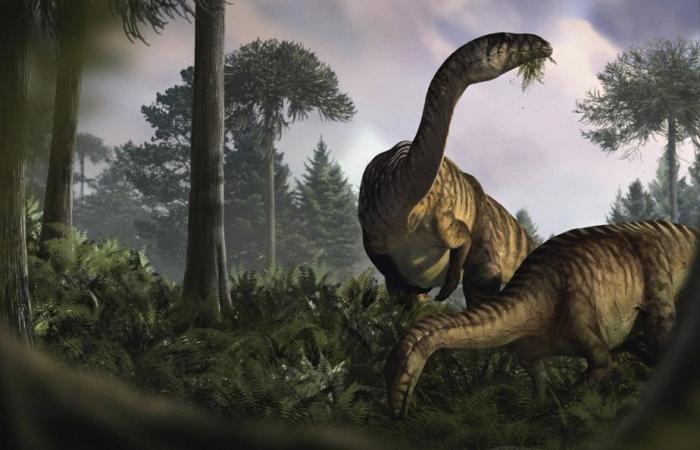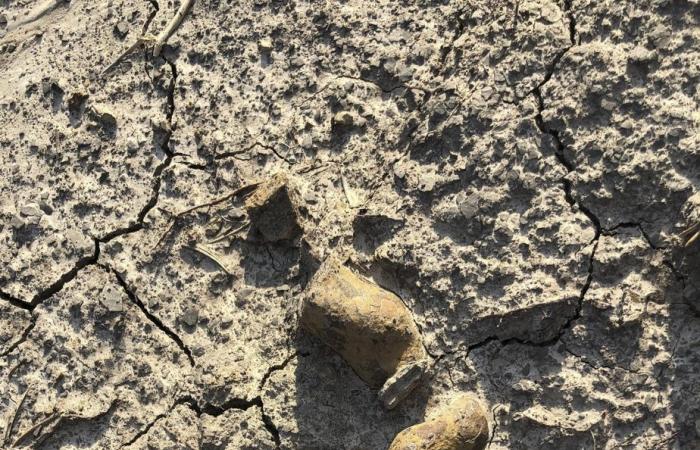(Paris) Excrement, vomit and fossilized remains of food in the intestine are all clues to the spectacular rise of dinosaurs to supremacy over the animal kingdom more than 200 million years ago, according to a published study Wednesday.
Posted at 12:15 p.m.
Pierre CELERIER
Agence France-Presse
Much is known about their existence and disappearance 66 million years ago. But “we know very little about their rise”, a real conquest of the world in around 30 million years, reminds AFP the paleontologist Martin Qvarnström, at the Swedish University of Uppsala, first author of the study published in Nature.
The team of researchers supervised by paleontologist Grzegorz Niedźwiedzki, also in Uppsala, provides an exhaustive review of more than 500 bromalites, the fossilized remains of what the dinosaurs of the Polish Basin digested, vomited and excreted.
By identifying their content and linking it to their producers, researchers “can begin to connect who ate who or what,” says Qvarnström. And thus show “how the ecological role of dinosaurs changed over time”.
The coprolites, fossilized excrement, were probed with cutting-edge techniques such as synchrotron microtomography. Which reveals almost intact beetles, fish vertebrae or teeth, plant fragments, crushed bones.
By crossing these data with those of paleontology and the evolution of climate and flora, they drew up a model of the progressive domination of dinosaurs.
“Precursors”
This is illustrated by the diameter and average length of vertebrate bromalites, which tripled for those from the Polish basin in 30 million years.
The size of their owners will follow, over this period from the end of the Triassic era to the beginning of the Jurassic.
The “precursors” of the lineage, the Silesaurus, are “rather small”, with barely a meter at the neck and weighing at best 15 kilos.
But where the dominant animal of the moment, the Dicynodontes, a species of quadruped barrel weighing a few tonnes, feeds exclusively on conifers, Silesaurus has a major advantage, it is omnivorous.
“When we study its droppings, we see that it eats all kinds of things, a lot of insects, fish and plants,” says Mr. Qvarnström.
PHOTO GRZEGORZ NIEDZWIEDZKI, FOURNIE PAR ASSOCIATED PRESS
The coprolites, fossilized excrement, were probed with cutting-edge techniques such as synchrotron microtomography.
Opportunistic and omnivorous, it will quickly adapt to radical changes in the environment, such as the Carnian rain episode. Carrier of humidity, it leads to a great diversification of the flora. Which surprises the large herbivores of the moment, unable to adapt to this change in diet.
Silesaurus, and later the long-necked herbivorous dinosaurs – ancestors of diplodocus – will “feast with these new plants”. Becoming larger and larger, they stimulated the growth of theropods, dinosaurs standing on two legs and mostly carnivorous.
So at the start of the Jurassic, the landscape was dominated by imposing herbivores and ferocious carnivores.
“A bit of luck”
“The dinosaurs were a bit lucky, but they were also very well adapted to this changing environment,” summarizes Mr. Qvarnström. The study is careful not to resolve the debate on the reasons for this supremacy.
It opposes supporters of “competitive exclusion” – attributing anatomical and physiological advantages to dinosaurs – to those of “opportunistic replacement” for whom they would have benefited from the disappearance of other groups, recalls professor of paleontology Lawrence H. Tanner, at Le Moyne Collège, in an article accompanying the study.
The Uppsala team speculates that a combination of these two approaches crowned the dinosaurs’ reign, with environmental changes coinciding with dietary adaptation.
This research should be seen as a “starting point for future work”, according to Lawrence Tanner.
Because even if it is based on a “particularly creative methodology”, with a range of remarkable technical means, it remains “limited in its context and its extent” to the Polish basin, which was then part of the supercontinent of Pangea.
Mr Qvarnström makes no secret of this. And hopes that the “model built in one area can be true for others”, particularly in the south of Pangea, which saw the appearance of the first real dinosaurs.







